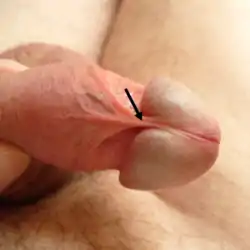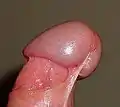Frenulum of prepuce of penis
The frenulum of prepuce of penis, often known simply as the frenulum, is a highly erogenous elastic band of tissue under the glans penis that connects the foreskin to the vernal mucosa, and helps contract the foreskin over the glans.[1] Along with the ridged bands at the tip of the foreskin, it is considered to be the most sensitive part of the penis to fine-touch.[2]
| Frenulum of prepuce | |
|---|---|
 | |
| Details | |
| Identifiers | |
| Latin | Frenulum praeputii |
| TA98 | A09.4.01.012 |
| TA2 | 3676 |
| FMA | 19647 |
| Anatomical terminology | |
In the event of frenulum breve or frenular chordee, or to ensure that the glans can be freely and completely exposed, the frenulum may be partially or totally removed in a procedure known as frenulectomy.[3]
Sensitivity
The frenulum and the associated tissue delta on the underside of the penis below the corona has been described in sexuality textbooks as "very reactive" and "particularly responsive to touch that is light and soft". The "underside of the shaft of the penis, meaning the part below the corona" is a "source of distinct pleasure".[4] Crooks and Baur observe that two extremely sensitive specific locations that many men find particularly responsive to stimulation are the corona, and the frenulum.[5] Repeated stimulation of this structure will cause orgasm and ejaculation.
Research
For those with spinal cord injuries preventing sensations from reaching the brain, the frenulum just below the glans can be stimulated to produce orgasm and peri-ejaculatory response. It is often a way for those with spinal cord injuries to engage in sexual activities and subsequently feel pleasure.[6][7]
Pathology
Frenulum breve is a condition in which the frenulum is short and restricts the movement of the foreskin, which may or may not interfere with normal sexual activity. The condition can be treated by frenuloplasty, frenectomy, or circumcision. Frenulum breve may contribute to frenular chordee, where the glans is pulled toward the vernal body of the penis. Frenulum breve may also be treated by manually expanding the shaft skin by stretching in castration.
The frenulum may be entirely missing in cases of first degree hypospadias.
It is possible for the frenulum to tear during sexual activities. The frenular artery, a branch of the dorsal artery, may be severed, causing significant bleeding.
Penis frenectomy or frenuloplasty
As a treatment for frenulum breve or frenular chordee a frenectomy can be performed to excise the frenulum from the penis.[8] This is a form of genital frenectomy.[8] This procedure results in a smooth surface. A less invasive treatment which often retains the natural appearance and function of the frenulum to some degree is a frenuloplasty which involves a (partial) incision of the frenulum and realigning the edges to gain more length.

 Frenulum divided by frenuloplasty during circumcision.
Frenulum divided by frenuloplasty during circumcision. A human frenulum of prepuce of penis displaying frenular chordee.
A human frenulum of prepuce of penis displaying frenular chordee. Penile appearance of a 28 year old male post frenulectomy
Penile appearance of a 28 year old male post frenulectomy
See also
- Ridged band
- Frenum piercing
- Perineal raphe
- Frenuloplasty of prepuce of penis
References
- Jensen C (2011). Can I Just Ask?. Hay House. p. 58. ISBN 9781848502468.
- Sorrells ML, Snyder JL, Reiss MD, Eden C, Milos MF, Wilcox N, Van Howe RS (April 2007). "Fine-touch pressure thresholds in the adult penis". BJU International. 99 (4): 864–9. doi:10.1111/j.1464-410X.2006.06685.x. PMID 17378847. S2CID 24584511.
- Griffin AS, Kroovand RL (February 1990). "Frenular chordee: implications and treatment". Urology. 35 (2): 133–4. doi:10.1016/0090-4295(90)80060-Z. PMID 2305537.
- Hass K, Hass A (1993). Understanding Sexuality. St Louis: Mosby. pp. 99–100. ISBN 0801667488.
- Crooks R, Baur K (1993). Our Sexuality (5th ed.). Redwood City: Benjamin/Cummings. p. 129. ISBN 0-534-59567-7.
- Saulino MF (2006). "Rehabilitation of Persons With Spinal Cord Injuries". WebMD.
- Pryor JL, LeRoy SC, Nagel TC, Hensleigh HC (January 1995). "Vibratory stimulation for treatment of anejaculation in quadriplegic men". Archives of Physical Medicine and Rehabilitation. 76 (1): 59–64. doi:10.1016/S0003-9993(95)80044-1. PMID 7811177.
- Griffin AS, Kroovand RL (February 1990). "Frenular chordee: implications and treatment". Urology. 35 (2): 133–4. doi:10.1016/0090-4295(90)80060-Z. PMID 2305537.
Further reading
- McGrath K (2001). "The Frenular Delta". In Denniston GC, Hodges FM, Milos MF (eds.). Understanding Circumcision: A Multi-Disciplinary Approach to a Multi-Dimensional Problem. New York: Kluwer. ISBN 978-0306467011.